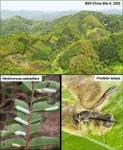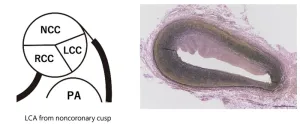(Press-News.org) In a new translational study from UCLA Jonsson Comprehensive Cancer Center, researchers analyzed genetic changes in the organs of recently deceased patients to understand how metastatic cutaneous melanoma spreads in those who had initially benefited from precision therapies. Results are published online ahead of print in Nature Medicine.
The researchers, including collaborators at the Lineberger Comprehensive Cancer Center in Chapel Hill, North Carolina, and the Vanderbilt-Ingram Cancer Center in Nashville, Tennessee, said unveiling the landscape of DNA and RNA alterations across multiple organs of metastasis may provide new direction in cancer therapeutics to address therapy failure.
“We hope to reconstruct, from the end of life, the lethal journey melanoma traverses across time and body sites,” said Dr. Roger Lo, a UCLA Jonsson Comprehensive Cancer Center researcher and a professor of medicine and molecular and medical pharmacology at the David Geffen School of Medicine at UCLA. “We need to know how many ways, even within the same patient, the cancer evades these powerful therapies, what underlying processes create ‘new species’ capable of escaping therapies, whether the cancer co-opts different organs to help it spread and resist therapies.”
Much of what scientists know about cancers and treatment comes from the first point of patient contact – when cancer is newly diagnosed, has not overtly spread in the body, and has not been treated, either surgically or with systemic therapy. Much less is known about cancer in patients with metastatic, terminal disease, possibly in hospice care, and for whom the medical establishment has little more to offer.
This research addresses these questions, using so-called “rapid” or “warm” autopsies shortly after death in previously consented patients to conduct “biopsies” that would not be ethically justified in living patients. Lo said the research team retrieved, within hours of death, tumors that had spread to all possible organs of patients who had initially benefited from precision therapies that have been developed over the past 10 to 15 years.
“We are taking a much-needed approach to understand cancer-related death, which usually results after the cancer has spread to distant sites, even after treatment with multiple systemic therapies. These therapies can be highly active initially but lose efficacy over time in a process termed ‘acquired therapy resistance.’ Alternatively, they may not work right from the outset through ‘innate resistance,’” said Lo, the article’s senior author.
The research team deciphered common-denominator mechanisms by which cancers become therapy-resistant, thereby providing critical clues to new therapeutic strategies. The scientists also found potential ways the metastatic cancer cells took advantage of specific organ environments, which points to the need for distinct approaches in treating patients with metastatic disease disproportionally affecting one or a few organs.
“The ability of cancers to escape precision treatments results from outgrowth of variant subpopulations that harbor traits allowing them to be impervious to the therapies, sometimes by taking advantage of a particular organ’s environment,” Lo said.
Cutaneous melanoma is regarded as one of the most metastatic and mutated human malignancies. Precision therapies targeting melanoma either block a critical cancer growth-and-survival pathway activated by mutations, or they reawaken the body’s cancer-killing T cells.
The researchers focused on two major subtypes of metastatic cutaneous melanoma classified by cancer-causing mutations in key genes called BRAF and NRAS. Patients whose melanoma harbors a BRAF gene mutation – found in about half of patients – have treatment options using either BRAF-targeted therapy or therapies known as immune checkpoint blockade. These are usually initiated one after another, such as when the first therapy fails to shrink tumors or stops working after a period of time. Patients whose melanoma harbors a NRAS gene mutation – found in about 20% of patients – have immunotherapy as their only standard-of-care option.
“We analyzed the DNA and RNA landscape from this autopsy cohort and, cognizant of the caveats of cross-study comparisons, singled out salient traits of terminal melanoma that distinguished it from early-stage melanoma and melanoma that had never been treated with either form of therapy,” said Sixue Liu, Ph.D., a post-doctoral fellow on the Lo team and the lead author.
Liu emphasized that this study found one of the two therapies – that which targets the BRAF mutation-activated MAPK pathway – can actually change the mutational profile of melanoma. Such a shifted mutational signature represents an imprint of DNA-mutagenic processes and/or defective DNA damage repair processes, which may have diagnostic or therapeutic implications.
“Warm autopsies represent a unique, precious, and humbling opportunity that allows for our deceased patients to ‘talk’ and guide next generations of treatments, such that future patients suffer less and live longer. It is clear that end-stage melanoma escapes both types of therapies by evading the immune system,” said Dr. Stergios Moschos, associate professor of medicine who led the rapid autopsy program at the University of North Carolina at Chapel Hill. “This study puts a sharp focus on alternative strategies to make the cancer visible to our body’s anti-tumor immune system.”
Article: Multi-organ landscape of therapy-resistant melanoma, Nature Medicine DOI: 10.1038/s41591-023-02304-9
Authors Additional authors include: Prashanthi Dharanipragada, Shirley H. Lomeli, Yan Wang, Xiao Zhang, Zhentao Yang, Raymond J. Lim, Camelia Dumitras, Philip O. Scumpia, Steve M. Dubinett, Gatien Moriceau of the David Geffen School of Medicine at UCLA and Douglas B. Johnson of the Vanderbilt University Medical Center.
END
In a ‘rapid autopsy’ study, UCLA researchers identify lethal molecular alterations after present-day therapies fail patients with metastatic melanoma
“We hope to reconstruct, from the end of life, the lethal journey melanoma traverses across time and body sites”
2023-04-27
ELSE PRESS RELEASES FROM THIS DATE:
New pancreatic cancer research could boost survival rates
2023-04-27
A unique treatment combining radiation and immunotherapy can eradicate pancreatic tumors while stopping the cancer from spreading, according to a new study by researchers at the University of Colorado Cancer Center.
The study, published today in the journal Cancer Cell, offers new hope to those with this often deadly disease.
“This is the first time we’ve seen the eradication of a pancreatic tumor that suggests the cancer cell has memory, meaning we can stop the disease from coming back,” said lead author Sana Karam, MD, PhD, member of the CU ...
ChatGPT scores nearly 50 per cent on board certification practice test for ophthalmology, study shows
2023-04-27
A study of ChatGPT found the artificial intelligence tool answered less than half of the test questions correctly from a study resource commonly used by physicians when preparing for board certification in ophthalmology.
The study, published in JAMA Ophthalmology and led by St. Michael’s Hospital, a site of Unity Health Toronto, found ChatGPT correctly answered 46 per cent of questions when initially conducted in Jan. 2023. When researchers conducted the same test one month later, ChatGPT scored more than 10 per cent higher.
The potential of AI in medicine and exam preparation ...
Ecology: Over 64% of suitable elephant habitat lost across Asia since 1700
2023-04-27
Habitats suitable for Asian elephants (Elephas maximus) across Asia have decreased by over 64% – equating to 3.3 million square kilometres of land – since the year 1700, estimates a study published in Scientific Reports. The authors suggest that habitat loss from 1700, after centuries of relative stability, coincides with the colonial-era use of land and subsequent agricultural intensification in South Asia.
Asian elephants live in a range of habitats including grasslands and rainforests, but with increasing human use of land and habitat loss, elephants can come ...
Citing growing evidence of harm to child health and learning ability, advocates call for faster replacement of diesel school buses
2023-04-27
Health and environmental advocates today called on communities, school boards and governments at every level to accelerate the electrification of school buses, replacing tens of thousands of diesel-powered school buses spewing toxic fumes that can seriously harm child health and interfere with learning.
Led by the Canadian Partnership for Children’s Health and Environment (CPCHE), a coalition of 34 organisations made the goal of all-electric school bus fleets in Canada the central focus of this year’s national Healthy Environments for Learning Day (April 27).
The joint call for urgent action by ...
Association of SARS-CoV-2 vaccination or infection with Bell palsy
2023-04-27
About The Study: This systematic review and meta-analysis suggests a higher incidence of Bell palsy (BP) among SARS-CoV-2–vaccinated versus placebo groups. The occurrence of BP did not differ significantly between recipients of the Pfizer/BioNTech versus Oxford/AstraZeneca vaccines. SARS-CoV-2 infection posed a significantly greater risk for BP than SARS-CoV-2 vaccination.
Authors: Amir Kheradmand, M.D., of Johns Hopkins University in Baltimore, and Mehran Rahimlou, Ph.D., of the Zanjan University of Medical Sciences in Zanjan, Iran, are the corresponding authors.
To access the embargoed study: Visit our For The Media website at this link https://media.jamanetwork.com/
(doi:10.1001/jamaoto.2023.0160)
Editor’s ...
Performance of an artificial intelligence chatbot in ophthalmic knowledge assessment
2023-04-27
About The Study: In this study that included 125 text-based multiple-choice questions provided by the OphthoQuestions free trial for ophthalmic board certification examination preparation, ChatGPT answered approximately half of the questions correctly. Medical professionals and trainees should appreciate the advances of AI in medicine while acknowledging that ChatGPT as used in this investigation did not answer sufficient multiple-choice questions correctly for it to provide substantial assistance in preparing for board certification at this time.
Authors: Rajeev H. Muni, M.D., M.Sc., of St. Michael’s Hospital/Unity Health Toronto in Toronto, is the corresponding ...
Comparison between ChatGPT and Google search as sources of postoperative patient instructions
2023-04-27
About The Study: The findings of this study suggest that ChatGPT provides postoperative instructions that are helpful for patients with a fifth-grade reading level or different health literacy levels. However, ChatGPT generated instructions scored lower in understandability, actionability, and procedure-specific content than Google Search– and institution-specific instructions.
Authors: Noel Ayoub, M.D., M.B.A., of the Stanford University School of Medicine in Stanford, California, is the corresponding author.
To access the embargoed study: Visit our For The Media website at this link https://media.jamanetwork.com/
(doi:10.1001/jamaoto.2023.0704)
Editor’s ...
Arthropods in high-diversity forests contribute to improved productivity
2023-04-27
An international team of researchers led by Prof. MA Keping from the Institute of Botany of the Chinese Academy of Sciences (IBCAS) has shown that forests with higher tree species richness tend to have greater arthropod diversity.
The researchers showed that higher tree diversity promotes productivity through the suppression of herbivores by enemy arthropods.
These findings, published recently in Nature Ecology & Evolution, underscore the importance of arthropod diversity as a mediator of the effects of tree diversity ...
Molecular autopsy sheds light on cause of sudden death of a child with COVID-19
2023-04-27
Researchers from Tokyo Medical and Dental University (TMDU) utilize an advanced DNA sequencing technique to reveal the factors that contributed to the death of a 5-year-old child with COVID-19
Tokyo, Japan – Sudden, unexplained child mortality is a tragedy; determining the cause of death is important for improving healthcare and providing loved ones with closure. Now, researchers from Japan have reported the use of an advanced DNA sequencing technique, whole-exome sequencing (WES), to determine why a young child died after a relatively mild infection.
In a study published ...
Bioinformatics specialists in Saarbrücken explore the molecular mechanisms of ageing
2023-04-27
A team led by bioinformatics experts Andreas Keller and Fabian Kern from Saarland University together with researchers at Stanford University have gained new insights into manifestations of ageing at the molecular level. They found that the process of reading genetic information does not run as smoothly in older individuals as it does in younger ones. These changes in the transcription process are due to particular RNA molecules that influence the activity of individual genes and thus determine which proteins the body produces – physiological ...
LAST 30 PRESS RELEASES:
Injectable breast ‘implant’ offers alternative to traditional surgeries
Neuroscientists devise formulas to measure multilingualism
New prostate cancer trial seeks to reduce toxicity without sacrificing efficacy
Geometry shapes life
A CRISPR screen reveals many previously unrecognized genes required for brain development and a new neurodevelopmental disorder
Hot flush treatment has anti-breast cancer activity, study finds
Securing AI systems against growing cybersecurity threats
Longest observation of an active solar region
Why nail-biting, procrastination and other self-sabotaging behaviors are rooted in survival instincts
Regional variations in mechanical properties of porcine leptomeninges
Artificial empathy in therapy and healthcare: advancements in interpersonal interaction technologies
Why some brains switch gears more efficiently than others
UVA’s Jundong Li wins ICDM’S 2025 Tao Li Award for data mining, machine learning
UVA’s low-power, high-performance computer power player Mircea Stan earns National Academy of Inventors fellowship
Not playing by the rules: USU researcher explores filamentous algae dynamics in rivers
Do our body clocks influence our risk of dementia?
Anthropologists offer new evidence of bipedalism in long-debated fossil discovery
Safer receipt paper from wood
Dosage-sensitive genes suggest no whole-genome duplications in ancestral angiosperm
First ancient human herpesvirus genomes document their deep history with humans
Why Some Bacteria Survive Antibiotics and How to Stop Them - New study reveals that bacteria can survive antibiotic treatment through two fundamentally different “shutdown modes”
UCLA study links scar healing to dangerous placenta condition
CHANGE-seq-BE finds off-target changes in the genome from base editors
The Journal of Nuclear Medicine Ahead-of-Print Tip Sheet: January 2, 2026
Delayed or absent first dose of measles, mumps, and rubella vaccination
Trends in US preterm birth rates by household income and race and ethnicity
Study identifies potential biomarker linked to progression and brain inflammation in multiple sclerosis
Many mothers in Norway do not show up for postnatal check-ups
Researchers want to find out why quick clay is so unstable
Superradiant spins show teamwork at the quantum scale
[Press-News.org] In a ‘rapid autopsy’ study, UCLA researchers identify lethal molecular alterations after present-day therapies fail patients with metastatic melanoma“We hope to reconstruct, from the end of life, the lethal journey melanoma traverses across time and body sites”



